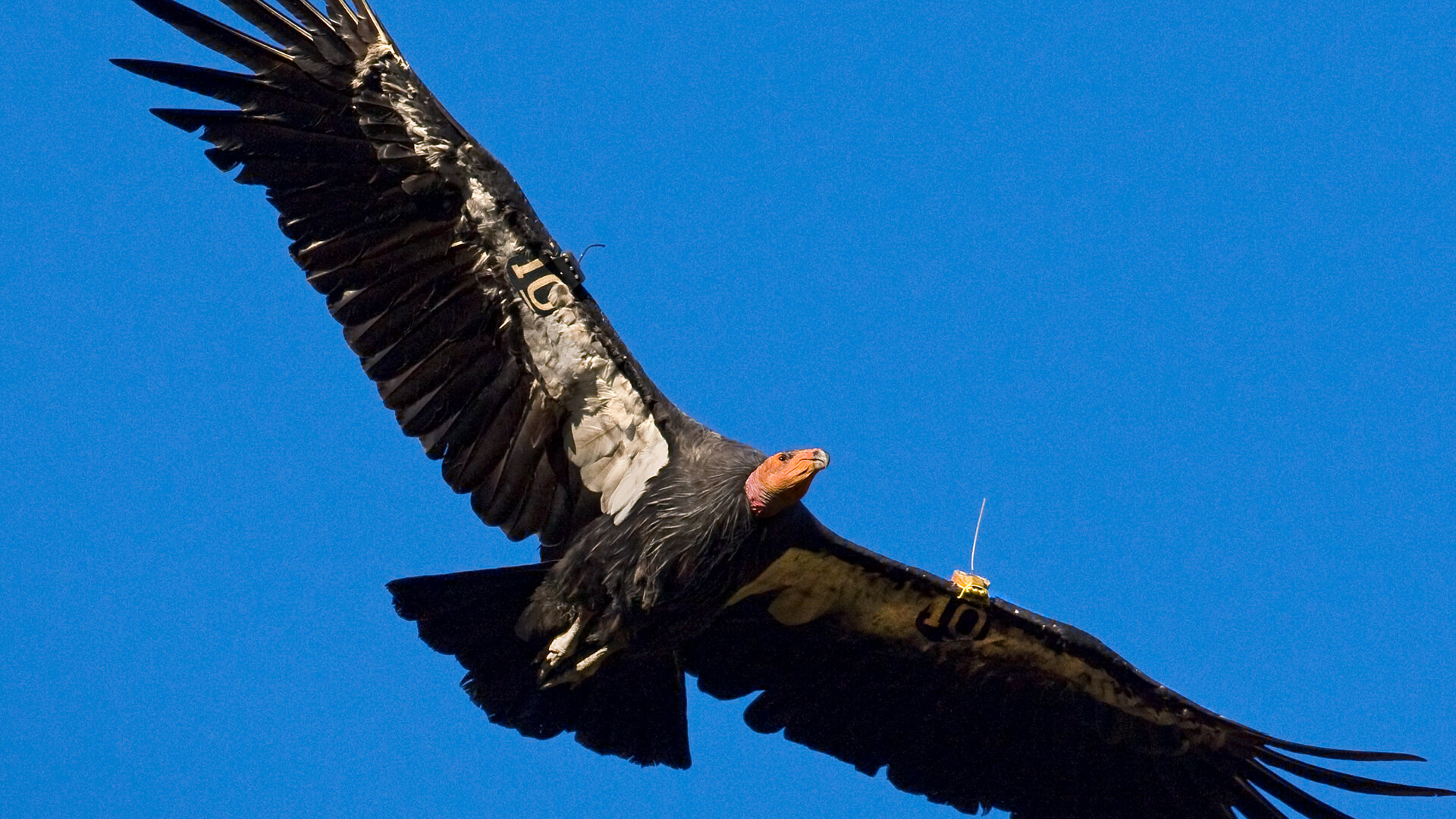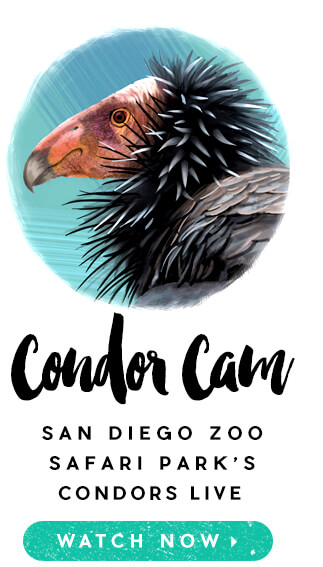
California Condor

- Class: Aves (Birds)
- Order: Cathartiformes
- Family: Cathartidae
- Genus: Gymnogyps
- Species: californianus

ABOUT
California condors are one of the largest flying birds in the world. They are known for their enormous black wings, extraordinary eyesight, and an inquisitive and engaging intelligence. At one time, thousands of California condors lived throughout the western United States and into Mexico. Fossil records indicate that California condors once inhabited present-day Florida and New York as well. Some indigenous tribes have called them "thunderbirds," associating the sound of thunder with the beating of their huge wings in the sky.
Large, triangular white patches under each wing distinguish California condors from other vultures. When in flight, their outstretched wings reveal that distinctive white patch and a massive wingspan—the largest of any bird in North America. The structure of condor wings and the placement of their feathers allow California condors to soar rather than flap their wings in flight. Condors catch thermal air currents that rise as the sun heats the ground, and with those huge wings they can stay aloft for hours, soaring through the skies as they scan fields below. They can reach flying speeds of 55 miles per hour (88 kilometers per hour), and altitudes of 15,000 feet (4,600 meters).
Although they eat rather messy meals, California condors work to keep themselves clean. After eating, they clean their head and neck by rubbing them on grass, rocks, or branches. Condors also bathe frequently and spend hours smoothing and drying their feathers. They also have a very hardy and effective immune system, so they don’t get sick from any of the bacteria they may encounter when feeding on carrion.
Adult California condors have a distinctive pink head and neck that is bare of feathers. This helps keep rotting food from sticking to them as they eat and may also help them regulate their body temperature. The skin on an adult condor’s head can even indicate some emotions. It turns a deep red-pink during courtship or when excited or alarmed. They also have an air sac that they can puff out during courtship displays or during moments of aggression.
HABITAT AND DIET
Condors prefer nest sites high on cliff ledges or cave openings with sand on the bottom. Holes in very large trees, like sequoias or redwoods, also make for great condor nest sites, although no nest itself is constructed for the egg and the condor pair doesn't add any nesting material.
California condors are vultures. Like all vultures, they are carrion feeders, not predators. They eat anything that is already dead, ranging in size from mice to beached whales. Condors do not have talons like hawks or eagles do; instead, their nails are more like blunt claws. They also do not have a toe that faces backward (opposing), so they cannot grasp or carry prey with their feet.
Condors prefer to eat fresh carcasses of large wildlife like deer, cattle, and sheep, but they also eat rodents, rabbits, and even fish. Unlike turkey vultures, condors don’t have a good sense of smell, so they find their food mostly with their keen eyesight. These large birds gorge themselves on 2 to 3 pounds (1 to 1.36 kilograms) of food at a time and can then go without food for several days until they find another carcass. Like other scavengers, condors are part of nature’s cleanup crew, helping break down organic matter and mitigate the spread of disease. Without them, things could get pretty messy!
When a condor finds a food source, it often cases out the situation for days, safely perched on a hillside watching a carcass, or it flies in a circle for a long time before landing. Eventually, the condor flies down to the feeding site to dig in. Other condors soon follow, with two or more birds often grasping the same piece of meat, rocking back and forth and using each other’s weight to rip it apart.
At the San Diego Zoo Safari Park, adult condors eat a variety of meat like rabbits, rats, beef heart, or trout. They are offered a variety of food, as they would naturally encounter different types of food in their native habitat. Condors don’t eat every day, so California condors at the Safari Park have “fast” days. This gives them a chance to digest what they’ve already eaten.
FAMILY LIFE
California condors have a complex social system. Condors, like other vultures, are social birds that share food and spend time resting near one another. They use a variety of body postures to communicate with one another to maintain social hierarchies. Condors don’t have a true voice box or syrinx like other birds, but they can make a few sounds by hissing and snorting. Chicks can make a high-pitched, scraping squawk, usually when begging or when out from under their parents for too long.
An adult female lays a single whitish or pale green-blue egg directly on the substrate of dirt, pebbles, or woodchips between January and May. Both parents incubate the egg and care for the chick, and they may only raise one chick every other year. If that egg is lost (predation, accident, etc.), the female may lay a replacement egg approximately a month later. Although adult condors have few predators (other than people), eggs and chicks may be attacked in the nest by ravens or golden eagles.
Breaking out of the egg isn’t easy for a condor chick. It uses a sharp point on its beak called an egg tooth to crack through the shell, but it can still take many hours, or even days, for a chick to completely break free. The chick hatches with bare skin on its head, neck, belly, and underwings. Both parents brood the chick, keeping it warm after hatching. They may squabble with each other for brooding time, but they soon settle into a routine, and the nest exchanges become much calmer.
After about a day, a chick can hold its head steady, and its parents then start providing food. Condor parents carry food to their young by storing it in a food storage area in their throat called a crop. The parents regurgitate this meat and feed it to their chick until it learns to pick up food itself.
At the end of a condor chick’s first week of life, it weighs around 10.5 ounces (300 grams). It grows much stronger but does not venture around the nest very much yet. Coordination improves, and it starts to interact with its parents: nibbling, preening, and nuzzling. When it’s about eight weeks old, the chick starts to wander outside of its nest area.
By five or six months of age, a young condor begins to practice flying. It learns the fine points of dining by observing its parents and peers. One of our researchers says condors act much like human teenagers—continuously jostling and squabbling for rank, resources, and respect. A chick may stay with its parents for up to two years but does not attain its adult plumage until it is five to six years old.
AT THE ZOO
The first California condor to live at the San Diego Zoo arrived in 1929. It was discovered with a damaged wing in Ventura, California, and came to the zoo for expert care. The condor’s wing required amputation, but it remained an active and healthy bird for over 10 years.
While condors historically lived throughout much of North America, condor populations dropped significantly over time. By 1982, only 22 condors survived in the wild, and the U.S. Fish and Wildlife Service began working with its partners to care for the remaining birds. San Diego Zoo Wildlife Alliance was given permission to begin the first zoological propagation program for California condors in the early 1980s. A special “condor-minium” with six large, free-flight aviaries was built at the San Diego Zoo Safari Park.
Then, in 1982, a condor named Xol-Xol was rescued at three months old after being neglected by his parents who were still raising another chick. He made his home at the San Diego Zoo Safari Park as the first California condor cared for by people through the California Condor Recovery Program. Not only did Xol-Xol thrive, he went from one of the last of his species on Earth to fathering more than 40 chicks and helping California condors make a mighty comeback.
The practice of caring for condor eggs through artificial incubation began in 1983, when the first California condor egg was received by the San Diego Zoo. Sisquoc, the first California condor ever hatched in a zoo, emerged from his shell on March 30, 1983. News of his hatching prompted an outpouring of mail from all over the world. Conservationists, zoos, governments, school classrooms, and many individuals sent congratulatory letters, all wanting to help with the condor project.
In 1987, the last California condor remaining in the wild, called AC9, came to the San Diego Zoo Safari Park. With California condors now extinct in their native habitat, half of the world's population lived at the Park. A new high point in condor conservation was reached when Molloko, the first condor bred in expert care, hatched on April 29, 1988. And in 1992, the first zoo-hatched condors were reintroduced into native California habitat in Los Padres National Forest.
Sisquoc continued to make the news when he and his mate, Shatash, were featured on our Condor Cam, raising their chick together. Viewers around the world watched the pair hatch and care for their chick, Saticoy. We are honored to have cared for more than 250 California condor hatchlings since Sisquoc's arrival so long ago.
Today, guests can see California condors up-close at the San Diego Zoo Safari Park’s Condor Ridge and in the San Diego Zoo’s Elephant Odyssey. You can also watch condors at the Safari Park’s "condor-minium" habitat on our live webcam. This Condor Cam offers a peek into ongoing recovery efforts at our breeding center. Join us as we care for condors at every age and stage: from hatching to preparing young birds for reintroduction into California, Arizona, and Baja California, Mexico.
Watch California condors daily on Condor Cam!
CONSERVATION
The California condor population was almost wiped out by the destruction of habitat, poaching, and lead poisoning by the mid-twentieth century. In 1982, only 22 California condors remained. San Diego Zoo Wildlife Alliance was given permission to begin the first zoological propagation program for California condors. The program also involved the U.S. Fish and Wildlife Service, California Department of Fish and Wildlife, the National Audubon Society, and the Los Angeles Zoo.
Thanks to the California Condor Recovery Program, within 20 years the population of California condors grew to almost 200 birds. It took a variety of techniques developed by scientists and wildlife care specialists to do this. Wildlife care specialists incubated condor eggs for hatching, hand-raised chicks with specially-made puppets that resembled adult condors (rather than through direct contact), and then offered mentorship by other condors to introduce natural social skills.
In the early 1990s, condors cared for by wildlife care specialists were reintroduced into California. Today, reintroductions take place at six different sites. One site is in northern Arizona at the Vermilion Cliffs, just north of Grand Canyon National Park. Four sites are in California: Bitter Creek National Wildlife Refuge north of Los Angeles, the Ventana Wilderness in Big Sur, Pinnacles National Park, and the Yurok Nation in northern California. About 40 to 50 California condors now join the population every year, and about 12 to 15 chicks now hatch in their native habitat annually.
Along with our Mexican partners, Secretaría de Medio Ambiente y Recursos Naturales, Instituto Nacional de Ecología, and COSTA SALVAJE, we participate in a long-term program to restore California condors to a sixth site in the Sierra San Pedro Martír of northern Baja California, Mexico, where they went extinct sometime in the mid-1930s, likely for the same reasons condors nearly disappeared in the United States: hunting, collisions with man-made objects, and lead poisoning. In 2012, we were honored to see the first condor to successfully fledge in Baja California.
Protection of condor habitat remains crucial for their ongoing survival. This is not always an easy task. Their main threat comes from environmental toxins, predominantly lead. When condors consume wildlife that have been shot with lead ammunition, they may accidentally ingest the lead, too. Since lead is a very soft metal, it can be digested and absorbed into the bloodstream, resulting in lead poisoning. Switching to lead-free ammunition can greatly aid the recovery of California condors. In fact, our pathologists have shown that lead poisoning is the most significant cause of mortality for condors. Despite legislation banning lead ammunition in California, condors continue to develop lead poisoning. You can help save condors by switching to non-lead ammunition and by encouraging others to do so, too.
Power-line collisions, exposure to pesticides, indiscriminate shooting, and micro-trash ingestion also pose threats to condors, but lead exposure remains the primary threat. Condors need strong and consistent winds to achieve soaring flight and to move around their habitat with energetic efficiency while searching for the widely dispersed carcasses that comprise their diet. A number of techniques help us learn about and protect condors, including radio telemetry, satellite GPS telemetry, binoculars, and telescopes. We not only study where they go and what they do, but also how they get there. By positioning a dozen remote sensing weather stations throughout their range, we're learning how they decide when and where to fly.
For example, sites for proposed wind-energy developments may pose a risk to condor populations because the strong winds that are attractive to condors are also attractive to companies planning to install wind turbines. Our work can help reduce the risk of condor turbine injuries by ensuring that they are situated at a safe distance from the major condor travel routes identified by our study.
Thanks to collaborative international efforts to protect and restore California condor populations, their populations have increased significantly since the 1980s. More than 560 California condors thrive today, with nearly 400 living in the wild. Their population recovery shows that we can truly create a world where all life thrives when we protect the ecosystems around us. More work remains to achieve population sustainability for California condors, but thanks to allies like you, there is hope for their future.
By joining San Diego Zoo Wildlife Alliance as an ally for wildlife, you help save species worldwide.
LIFE SPAN
Condors can live up to 60 years.
YOUNG
Number of eggs: 1
Incubation: 53 to 60 days
Maturity: 5 to 6 years old
SIZE
Wingspan: 8.2 to 9.7 feet (2.5 to 3 meters)
Weight: 16 to 25 pounds (7 to 11 kilograms)
FUN FACTS
When a condor that hatched at the San Diego Zoo Safari Park was reintroduced in Mexico in 2002, it later crossed the U.S.-Mexico border in 2007. This was the first time a California condor had been seen in San Diego County in nearly 100 years.
California condors do not have vocal cords, so they only make hissing and grunting noises.
It can take up to a week for a hatching California condor chick to break out of its egg.
With few natural enemies other than people, California condors are curious and bold.
The San Diego Zoo was the first zoo in the world to hatch a California condor.
California condors lay just one egg a year—the lowest reproductive rate of any bird.
California condors can eat up to three and a half pounds of food at a time.
All California condors are now descended from only 13 founders.











